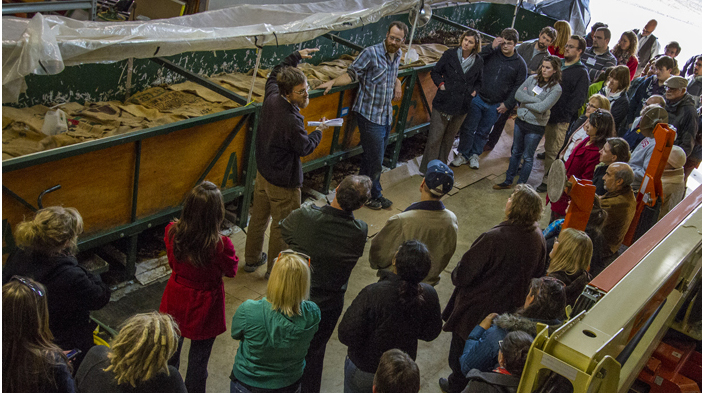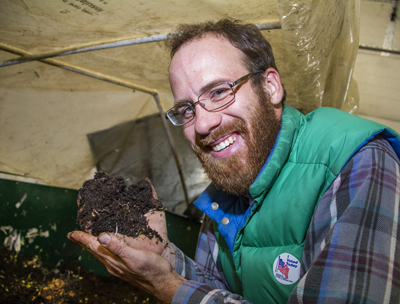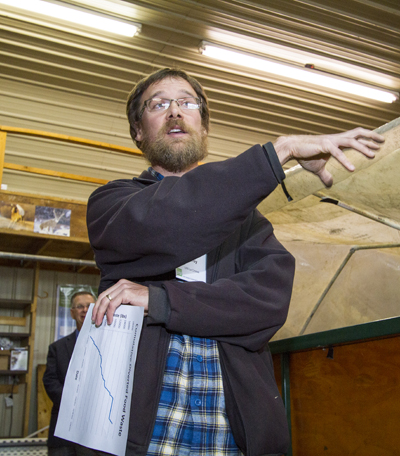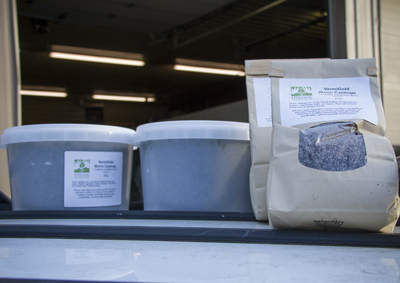Posted 8:14 p.m. Wednesday, Nov. 21, 2012

Student investment in vermicomposting system has transformed tons of campus food waste into high-value soil.
 Nine tons of waste transformed into a resource with help from UW-L Green Fund
Nine tons of waste transformed into a resource with help from UW-L Green Fund
A student sustainability initiative that started in 2011 has turned tons of UW-La Crosse food waste into high-value soil.
Students allocated $17,000 in segregated fees to purchase a vermicomposting system in spring 2011. Through the power of worms, it turns food waste into high-value soil.
Since the system started, nine tons of food waste from UW-L Dining Services has been turned into vermicompost, according to UW-L Geography and Earth Science Assistant Professor Ryan Perroy. The magic ingredient in the mix is about 400 pounds of Red Wiggler Worms.
[caption id="attachment_17556" align="alignright" width="400" caption="Zack Gaugush, vermicompost manager for Hillview Urban Agriculture Center, explains how the system works. HUAC, a local non-profit organization focused on sustainability, maintains the vermicomposting system and provides logistical support."] [/caption]
Zack Gaugush, vermicompost manager for Hillview Urban Agriculture Center (HUAC), one of the partners on the program, calls using the system a “no brainer.”
“If you’ve invested and are already paying a set amount for food to be transported and processed into a meal, instead of paying someone to haul it away and put it in a landfill, you can recapture all the nutrients and turn that into a resource,” he explains.
The unit holds about 400 pounds of living worms. Under ideal conditions, the worms can eat their weight in a day — meaning a max of 400 pounds of food waste can be dumped each day. However, Gaugush says they’ve never hit that mark. He collects food waste from the Whitney Center and dumps an average about 500 pounds of it into the system each week — or about 83, five-gallon buckets full. UW-L plans to work to increase the amount to include food scraps from Cartwright Center and possibly residence halls.
The system takes pre and post consumer
[caption id="attachment_17559" align="alignright" width="400" caption="UW-L Geography and Earth Science Assistant Professor Ryan Perroy is a major contributor to the project. Earlier this fall he explained how the vermicomposting system works to about 70 people from schools throughout the UW System. The faculty, staff and students were on campus for their annual sustainability meeting."]
[/caption]
Zack Gaugush, vermicompost manager for Hillview Urban Agriculture Center (HUAC), one of the partners on the program, calls using the system a “no brainer.”
“If you’ve invested and are already paying a set amount for food to be transported and processed into a meal, instead of paying someone to haul it away and put it in a landfill, you can recapture all the nutrients and turn that into a resource,” he explains.
The unit holds about 400 pounds of living worms. Under ideal conditions, the worms can eat their weight in a day — meaning a max of 400 pounds of food waste can be dumped each day. However, Gaugush says they’ve never hit that mark. He collects food waste from the Whitney Center and dumps an average about 500 pounds of it into the system each week — or about 83, five-gallon buckets full. UW-L plans to work to increase the amount to include food scraps from Cartwright Center and possibly residence halls.
The system takes pre and post consumer
[caption id="attachment_17559" align="alignright" width="400" caption="UW-L Geography and Earth Science Assistant Professor Ryan Perroy is a major contributor to the project. Earlier this fall he explained how the vermicomposting system works to about 70 people from schools throughout the UW System. The faculty, staff and students were on campus for their annual sustainability meeting."] [/caption]
vegetables, fruits, coffee grounds, tea and egg shells — no meat, dairy or grain. The Red Wiggler Worms — living near the surface of the soil — make their way up to eat the compost.
“They rise to the occasion — so to speak,” says Gaugush.
Worms digest the food and excrete castings, or, as Perroy likes to call them, “high-value, agricultural amendments.” Over time the castings fall to the bottom of the container and are collected. This finished material is a nutrient-rich natural fertilizer and soil conditioner, which HUAC, a local non-profit organization focused on sustainability, sells or uses at its green house.
“Vermicomposting is ancient. If you have a compost pile outside, you’ll find worms in it. Yet this sort of system used on an institutional scale is relatively new,” says Gaugush. “That’s born out of people’s interest in turning waste into a resource.”
It is also a good learning tool, says Perroy. UW-L students have participated in managing the system and some have conducted research in relation to the project. Perroy hopes the system eventually comes full circle, using the vermicompost on UW-L greens.
The system is currently located in a warehouse off Hwy. 16 near the Viterbo University baseball fields, however, it will eventually be moved to the Western Technical College campus. Recently, Gaugush started collecting food waste
[caption id="attachment_17562" align="alignright" width="400" caption="Hillview Urban Agriculture Center sells the finished soil product."]
[/caption]
vegetables, fruits, coffee grounds, tea and egg shells — no meat, dairy or grain. The Red Wiggler Worms — living near the surface of the soil — make their way up to eat the compost.
“They rise to the occasion — so to speak,” says Gaugush.
Worms digest the food and excrete castings, or, as Perroy likes to call them, “high-value, agricultural amendments.” Over time the castings fall to the bottom of the container and are collected. This finished material is a nutrient-rich natural fertilizer and soil conditioner, which HUAC, a local non-profit organization focused on sustainability, sells or uses at its green house.
“Vermicomposting is ancient. If you have a compost pile outside, you’ll find worms in it. Yet this sort of system used on an institutional scale is relatively new,” says Gaugush. “That’s born out of people’s interest in turning waste into a resource.”
It is also a good learning tool, says Perroy. UW-L students have participated in managing the system and some have conducted research in relation to the project. Perroy hopes the system eventually comes full circle, using the vermicompost on UW-L greens.
The system is currently located in a warehouse off Hwy. 16 near the Viterbo University baseball fields, however, it will eventually be moved to the Western Technical College campus. Recently, Gaugush started collecting food waste
[caption id="attachment_17562" align="alignright" width="400" caption="Hillview Urban Agriculture Center sells the finished soil product."] [/caption]
from Western as well. The system is a partnership between UW-L, Western and HUAC.
At UW-L, vermicomposting is one of many ways the campus is working to be more sustainable. Other campus sustainability initiatives include installing low-flow shower heads in the majority of residence halls, earning Leadership in Energy and Environmental Design certification on newly constructed buildings, reducing electrical consumption with energy efficient lighting and more.
[/caption]
from Western as well. The system is a partnership between UW-L, Western and HUAC.
At UW-L, vermicomposting is one of many ways the campus is working to be more sustainable. Other campus sustainability initiatives include installing low-flow shower heads in the majority of residence halls, earning Leadership in Energy and Environmental Design certification on newly constructed buildings, reducing electrical consumption with energy efficient lighting and more.
